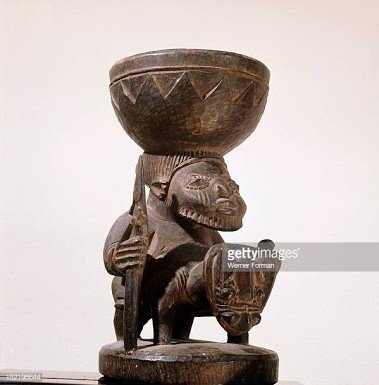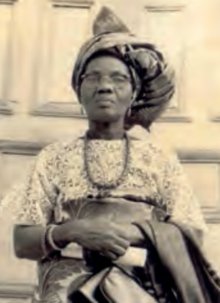Uncounted numbers of Yoruba men, women and children were sold by their Tribesmen,and were shipped bounded in Chains at the Neck, Leg & Hands,to Portugal, Britain, Americas etc
Unfortunately, so many Yoruba Elites got Wealthy through this Nefarious Trade.
* The Origin of the Yoruba People ,
* The life style/Culture/traditional Worships of the Yorubas before the White man visiting,
*The Involvement of Some Yorubas in the Transatlantic Slave Trade Business,
* The Story of Efunseyitan Aniwura who has over 2000 slaves working in her farms
* The Abolition of Slave Trade and Some Notable Slave Returnees in Nigeria.
So, if you guys are ready,........Let's Go.
They offered him Palm Wine and he drank too much and fell asleep.
Oduduwa, his younger brother, saw Orishala Sleeping.
He then took the materials and went to the edge of heaven, accompanied by Chameleon.
Oduduwa stayed at Ilé-Ifẹ̀, that is why sees Ife as their Ancestral home..
Ife tradition is headed by Ooni of ife
Oduduwa Son,Oromiyan ruled Oyo and his the father of the first Oba of Benin,Eweka.
Within the Yoruba Society, you could find not only culture and religion,but also Hardworking,kind-hearted,Faithful and self-sacrificing people.
¶ A Single Shell displayed Or given
away may communicate failure and defiance.
¶ If a Yoruban wished to affirm relationships between himself and a Brother Or Sister, he may
deliver to them two Shell's strung together, face to face.
¶ Two Shell's strung, back to back, represented enmity and separation.
¶ likewise, If the Yoruban wished to have an immediate and friendly meeting with
someone, he would tie a Small feather between two facing shells.
lastly, some being Malignant Spirits.
But, the Yoruba traditional religion holds that there is one supreme being Olorun/Eledumare, who is the source and creator of life (Aye)
Some Yoruba god's:
And so many others, too numerous to mention
A husband is responsible for settling quarrels within his own family.
The Yoruba practice polygyny (having more than one wife).
Let's look.at her Story.
Her real name is Efunporoye Osuntinubu Olumosa, but it is often shortened to Tinubu.
Madam Tinubu was born in the Ojokodo forest area of Egbaland.
Her father's named Olumosa a farmer, While her mother's name is Nijeede a trader.
When she was little, She do follow her mother to Abeokuta from Egbaland when a lot of the villages around were being Killed following the Yoruba wars of 1821.
She grew up to become a politically significant figure in Nigerian history because of her roles as a powerful female aristocrat and slave trader in pre colonial and colonial Nigeria ..
Tinubu was married four times in her lifetime.
As a widow and single mother, she took to business and was successful thanks to her grandmother and mother who were business women.
After Prince Adele lost out on the Obaship of Lagos, he decided to tour Abeokuta on a goodwill visit to thank the people for their support.
She then moved with her new husband to a place called Agbadarigi (Badagry) in Lagos.
Badagry was traditionally the place of refuge for Lagos monarchs.
Madam Tinubu arrived at Badagry at a time when the then illegal Transatlantic slave trade was peaking on the eastern Slave Coast.
Despite her lack of formal education,She expanded her business activities to include Slaves,Arms and ammunition and also established a flourishing trade in tobacco and salt.
The exiled Oba Adele was still in Badagry when his successor, Oba Idewu, died. Prince Kosoko, Idewu Ojulari's brother, was a major contender for the now vacant throne.
The new Oba then ruled with his new Queen, Efunroye Tinubu.
As Queen of Lagos,Tinubu used her royal authority to solidify her Slave Trade business empire.
The enterprising Madam Tinubu was later to expand her trade,..
Oba Oluwole had regular clashes with Prince Kosoko because he felt he was the true heir to the throne of Lagos.
To curb his excesses, Prince Kosoko was banished from Lagos by Oba Oluwole.
Madam Efunroye Tinubu married for the third time, to Yesufu Obadina who was the Oba of Lagos, Oluwole's Military Chief.
And with the support of Oba Oluwole, Tinubu and Obadina grew their empire by increasing trade with the Egbas.
The ammunition she got from selling slaves were used in the Yoruba wars of 1840s and 1850s.
And In return, Oba Akitoye gave her important stores in the choice area of Lagos.
She also built a might residence for herself at this time to reflect her position in Lagos. At this period Madam Tinubu invested in coconut oil and cotton also.
Madam Tinubu was often accused of bending the thrones power to her personal and business advantage. This was evident by her influence in Akintoye’s palace.
But,She was unable to control Oba Akitoye as much as was as people thought.
While on exile, Madam Tinubu used her status as a wealthy woman, to influence economic and political decisions.
In December 1851, the British bombarded Lagos under the guise of wanting to end the
slave trade business in Lagos.
She also established secret Trades of Slaves for guns with Brazilians and Portuguese traders building herself an army.
In what was termed reckless, she broke more treaties and used the power of the throne for herself. a conflict developed between Tinubu and some slave traders ...
Possu, Ajenia,and other traders tried to instigate an uprising against Akitoye in 1853 because of Madam Tinubu's influence in Lagos.
In the interest of peace, Benjamin Campbell,the British Consul in Lagos, asked Akitoye to exile Madam Tinubu.
Under Oba Dosunmu’s reign, Madam Tinubu had an army she armed with the guns from the Brazilians ...
Due to the sheer volume of her army, she sometimes executed orders that could only be taken by a King.
She was seen as the real owner of the throne and her influence grew even more.
This made Oba Dosunmu to be scared of her influence in Lagos.
Madam Tinubu tried to influence Oba Dosunmu to limit the influence of Slave returnees but he refused to give in to her request consequently she started and led a rebellion against the Brazillian and Sierra Leonean slaves turned ...
Her outrage displayed a type of nationalism that worried the British masters.
In February 1856, Madam Tinubu monopoly and control of power in Lagos was broken,when she also challenged the British Consul.
So, She tried to oust the British Console,but it failed.
In May 1856,Tinubu was banished from Lagos to Abeokuta.
EXILE IN ABEOKUTA :
While, In Abeokuta, Tinubu expanded her business activities to include gunpowder and bullets.
She became involved in Abeokuta king-making activities as well,S upporting Prince Oyekan over Ademola for the Alake of Egba title in 1879.
In 1864, she was awarded the title of Iyalode (First Lady).
There has been Many publications (notably those that promote black history) that have asserted that Madam Tinubu later became a changed person after learning about the evils of the Transatlantic Slave Trade.
On one occasion,during her final sojourn in Abeokuta,She was alleged to have Sold a young boy into slavery and was accused of it
Madam Efunroye Tinubu had another marriage making it her 4th, with one Alhaji Momoh Bukar, an Arabic scholar.
Momoh Bukar's children from other wives later adopted the Madam Tinubu's name.
In 1887, Madam Efunroye Tinubu died.
She was buried at Ojokodo Quarters in Abeokuta.
Tinubu Square on Lagos Island, a place previously known as Independence Square, is named after the late Oloye.
Ita Tinubu (Tinubu's precinct or Tinubu Square) ..
Likewise a Female Hostel in University of Lagos is named after her.
ammunition, back to the hinterland.
Story has it that she has Over 2000 Slaves working on her own personal farms.
Efunsetan Aniwura was a very Wealthy Woman and a very Close Friend of Madam Efunroye Tinubu.
Efunseyitan Aniwura was Born in Abeokuta in the 1790s.
She was a migrant from Egba in present day Ogun State.
Her father's name was Ogunrin, who was a warlord from Ikija, Egba Land.
while her mother is from ile Ife, she was a business woman.
RISE AND FALL :
Efunseyitan Aniwura's business speciality was in arms and ammunition, and she has her own Strong Army.
She also manufactured a local cream Product, Kijipa, that was exported to America and Europe.
In 1867, Efunsetan Aniwura was made Iyalode of Ibadan. Making her the second
Iyalode of Ibadan, taking over from Iyalode Subola, 1850-1867.
Efunsetan Aniwura's childless affected Psychologically, because she had no one to inherit her wealth.
Also, at that time, having a successor was seen as a major determinant of affluence.
And because she has None,
It was said that, she whipped and starved her slaves.
She also created rules that ensured that no slave in her household Should have Sex.
was childless after losing her only child, she would kill any of her
female slaves that became pregnant and any male slave that got her Pregnant Or proposed love.
There was a Particular issue of One of her female workers who broke the law by getting pregnant.
Efunsetan Aniwura didn't think twice and she ordered that the slave lady be Executed.
Due to her excessive behaviour, Efunsetan was Eventually found guilty of the contempt by the council of chiefs, the traditional court in Ibadan
back in the day,but she refused the punishment of self-exile.
It was said that, Efunsetan Aniwura also Possesses Spiritual Prowess, Black Magic, Witchcraft, Voodoo etc
Efunseyitan do lend Arms, Ammunition and sometimes her Slave Warriors to the Ibadan Military, headed by Aare Latoosa.
Efunseyitan does contribute to discussions regarding issues of Ibadan war s and peace,..
politics.
Aare Ona Kakanfo
Latoosa (also spelt Latosa) was a powerful general, warrior and warload who fought in the Kiriji wars.
usual support. As a result Latoosa set out on a War without as much arms as he expected, when he returned he had a bone to pick with Efunsetan.
The next Iyalode of Ibadan was Iyalode Iyaola (1874-1893).
Efunseyitan Aniwura's authority, Influence in Ibadan Politics and opposition to the political views of the Ibadan community head, Aare Ona Kakanfo Latoosa, led him to plot to execute her.
The first account of her death, was that :
In 1874, Latoosa paid Efunseyitan's adopted Son, Kumuyilo, to betray her and murder her.
Kumuyilo then hired
two of Efunsetan's slaves, who bashed Efunsetan’s head while she was asleep.
However, the family protested and insisted on an investigation into Efunsetan'",s Mysterious death.
Latoosa later bowed to pressure from Egba and Ibadan Chiefs to investigate Efunseyitan's murder
Kumiyilo then indicted 3 of Latoosa’s close aides in the
murder.
At the End, Kumiyilo was deposed as the head of Efunsetan family.
While, the actual murderers were executed.
Efunseyitan Aniwura's statue is placed at the center of challenge roundabout, a major point within the city of Ibadan.
These returnee families settled mainly in Lagos due to its European Occupying base, and Job Opportunity.
John was the English name given to him by his Slave master.
"Nottidge returned to Lagos and entered government service. When Lagos became a British colony, he became its first jailer."
"Gooding became an important figure in Lagos in the 1850's and 1860's. Vice-president of the Sierra Leonian Court in 1855, he was later president of the African Commercial Association, started in Lagos in 1863,..
"Turner was an Egba, captured as a boy, sold tot a slave trader, and subsequently liberated at Sierra Leone. He was said to have been closely related to prominent chiefs in Abeokuta. He returned to Lagos in 1853 and soon became a prosperous trader,..
Sources : NGU Library Collection, Wikipedia, MENY Journals, Ayomide O. Tayo, Oladipo Yemitan, Jean Headlight Kopytoffist, S. G. Pinnock, Nigeria History Archive
#Nzekwe Gerald Uchenna (NGU)
#MovementForTheEmancipationOfNigerianYouths(MENY)






















































